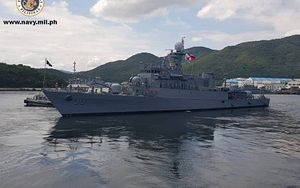On August 18, the Philippines officially received a vessel that South Korea had donated to Manila. Though the event had long been in the works, it nonetheless highlighted one significant manifestation of the Southeast Asian state’s ongoing naval modernization.
As I have noted before in these pages, among the developments within the Philippines’ ongoing evolution of its naval capabilities – with Manila still significantly lagging some of its neighbors in this realm –is the status of a donated South Korean Pohang-class corvette, which was subsequently assigned the name the BRP Conrado Yap. The vessel, viewed as an important boost to the Philippine Navy in various areas including an anti-submarine capability, was expected to arrive earlier this year. Following some delays, it finally set sail to the Philippines in early August.
Over the past week, the BRP Conrado Yap has been in the headlines again with its arrival in the Philippines and a focus on its future as well as other related developments within Philippine military modernization. The vessel arrived in the Philippines in the morning of August 18, after which we saw a series of comments by Philippine defense officials about its significance and other potential inroads that could follow as well.
Unsurprisingly, the arrival of the BRP Conrado Yap and its welcoming ceremony saw remarks by various officials about the significance of the development for Philippine defense policy. For instance, Philippine Fleet Commander Giovanni Bacordo, in remarks to reporters, reinforced the fact that this would be a boost to the country’s anti-submarine warfare capabilities and its ability to counter a range of naval and aerial challenges.
Beyond this, with the vessel now having arrived in the Philippines, we also saw a focus on what role it would play within Philippine security. Defense Secretary Delfin Lorenzana said on the sidelines of the welcoming ceremony for the BRP Conrado Yap that depending on how soon the ship could be brought to bear, it could play a role in helping safeguard the country’s waters off of Palawan, which fronts the South China Sea, or Sulu, and has long been a hub for transnational crimes. It is also the site of emerging minilateral security collaboration.
There was also an emphasis on other related developments as well. For example, Philippine Navy chief Robert Empedrad mentioned that he hoped that the Philippines would get two more Pohang-class corvettes in the future, reiterating previous comments in this vein as well. And per the Philippines News Agency, Philippine Navy acting spokesman Henry Quinto reiterated the importance of this as well, noting that having at least three ships within this class would be a boost since it would help ensure that one ship could always be on patrol while the other two would be undergoing training or being kept in reserve.
To be sure, it remains unclear how much of the aforementioned ambitions with respect to the BRP Conrado Yap and other related activities will actually be realized. But the arrival of the vessel nonetheless provided a sense of how it fits into broader Philippine naval modernization and future developments in this realm.

































